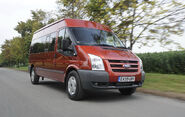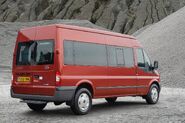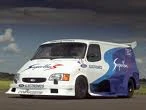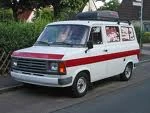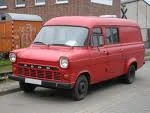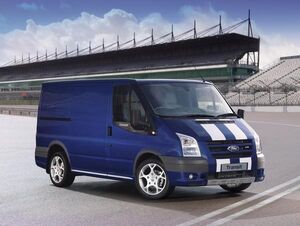
| |
| Ford Transit | |
|---|---|
| Ford | |
| aka | Ford Tourneo |
| Production | produced from when to when+total units made (optional) |
| Class | Commerical |
| Body Style | SWB Van LWB Van LWB High-top van 2-door cutaway van chassis 4-door cutaway van chassis |
| Length | length - type here |
| Width | Width - type here |
| Height | Height - type here |
| Wheelbase | wheelbase - type here |
| Weight | Weight - you get the point |
| Transmission | 6 speed Manual, FWD/RWD |
| Engine | 2.4 litre TDCi Inline-4 |
| Power | N/A hp @ N/A rpm N/A lb-ft of torque @ N/A rpm |
| Similar | Chevrolet Express Citroën C25/Citroën C35/Citroën Jumper Fiat 242/Fiat Ducato FSC Lublin Opel Movano Iveco Daily Mercedes-Benz T1/Mercedes-Benz Sprinter Peugeot J5/Peugeot Boxer Hyundai H-1 Hyundai H350 Nissan Trade/Nissan Interstar/Nissan NV400 Renault Master Volkswagen LT/Volkswagen Crafter GAZelle-Next |
| Designer | Designer (lead designer if it was a team effort) |
The Ford Transit is a panel van sold in Europe (inc. Turkey) it has been around for more than 45 years and more than 6 million Transits have been sold altogether. The first Transit was built in August 1965. One Transit "supervan" reached 150MPH.
Recent Changes[]
- For 2011, Ford UK is launching the 100 unit limited edition SportVan Limited. It is differentiated from the standard Transit by Colorado Red paintwork and Le Mans-style white bonnet stripes, twin exhaust tail pipes, 18-inch graphite color alloy wheels shod in low profile 235/45 tires, front and rear lower spoilers, side skirts and extended wheel arches, optional LED cargo lights and LED daytime running lights, velour interior trim along with standard air conditioning, six CD-player with remote steering-column-mounted controls, cruise control, power windows, powered and heated mirrors, leather steering wheel, tinted glass, leather gearshift knob, a perimeter alarm, power deadlocks, rain-sensing wipers, auto headlights, front fog lights, a load area protection kit, ABS, ESP and driver and passenger airbags. Available options include leather seats and a navigation system with a 5-inch color display. Prices start at £22,630.[1]
Styles and Major Options[]
Certain vehicles come in different trim levels or body styles. Features and major options should be mentioned here.
Pricing[]
Add more fields as necessary.
| MODEL Trims | |||
|---|---|---|---|
| Trim1 | Trim2 | Trim3 | Trim4 |
| MSRP | |||
| $Price1 | $Price2 | $Price3 | $Price4 |
| Invoice | |||
| $Price1 | $Price2 | $Price3 | $Price4 |
Gas Mileage[]
Add more fields as necessary.
As seen on the FuelEconomy.gov website, the City/Highway MPG averages are as follows:
| Trim | |||
|---|---|---|---|
| Trim1 | Trim2 | Trim3 | Trim4 |
| MPG | |||
| c/h | c/h | c/h | c/h |
Engine and Transmission[]
Specifications, details, graphs, pictures and other information regarding the powertrain is placed in this section.
Performance[]
Please make sure to write information of the vehicle's performance in a third-person point of view. This section should include information about the car's acceleration figures, handling, braking, etc.
If using information gathered from Road Test articles from a reputable automotive source, then please make sure to cite the quote.
Reliability[]
Warranty options and scheduled maintenance information should be mentioned here.
RECALL ALERT: In Transit RWD Diesel models built between 29th March 2006 and 12th December 2006, there is a fault with the pump retaining snap ring within the nut connection of the power steering pump. The snap ring could wear and detach cauing the power steering fluid to leak resulting in a loss of power steering. The worst case scenario could be that the fluid could fall onto the exhaust manifold causing a fire. However, a retaining collar has been developed to ensure the problem will not happen again. [2] [3]
RECALL ALERT: In RWD Transit models built from 15th March 2004 to 1st March 2006, there has been a rear axle defect. Affected models may experience wearing conditions between the axle shaft and the differential pinion shaft. [4]
Safety[]
This section should reference points on safety ratings and features of the vehicle.
Photos[]
Colors[]
List the colors that the particular <MODEL> is offered in.
Main Competitors[]
- Volkswagen Crafter
- Volkswagen Volt
- Dodge Sprinter
- Mercedes-Benz Sprinter
- Fiat Ducato
- Citroën Jumper
- Peugeot Boxer
Hybrid Models[]
If there are hybrid versions of this vehicle manufactured, then please elaborate a little bit on it here.
Unique Attributes[]
If there are any features of this vehicle that sets it apart from other vehicles in its class, then mention those unique attributes here.
Interior[]
This section should include information on the interior's design, build quality, ergonomics, space (head and legroom, front and rear), features, stowage compartments and overall comfort and livability. Add pictures wherever applicable and keep information in a third-person point of view.
Resale Values[]
Add more fields as necessary.
| <MODEL> Year | |||
|---|---|---|---|
| Year X | Year X-2 | Year X-3 | Year X-4 |
| Resale Value | |||
| $ | $ | $ | $ |
Criticisms[]
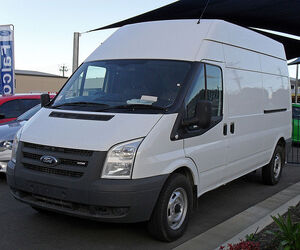
2007 Ford Transit
Please make sure to keep critiques in a third-person point of view. If using criticisms from a reputable automotive source, then please make sure to cite the quote.
Generations[]
Mk 1[]
The first (after-Ford Model T pickup and van (1917-1925), Ford Model T pickup and van (1925-1927), Ford Model A (1927-1929), Ford Model A pickup and van (1930-1932), Ford Model B pickup and van (1932-1934), Ford Model 48 pickup and van, Ford Pilot V8 pickup and van, Fordson Thames E83W, and Fordson Thames 400E) generation Transit, or the Transit Mark I in the United Kingdom,[1] was introduced in October 1965, taking over directly from the Thames 400E. This generation had the longest production run of any Transit to date, staying largely unaltered for 12 years until the major update of 1977, with only one minor facelift for the 1971 model year, which saw updated front end styling on the V4 engined models (the 'pig snout' diesel/V6 models remained unchanged), and the introduction of a safety padded dashboard.
Overall production of this platform therefore lasted for over 20 years before finally being replaced by the all-new VE6 platform in 1986.
The van was produced initially at Ford's Langley facility in Berkshire, England (a former Second World War aircraft factory which had produced Hawker Hurricane fighters), but demand outstripped the capability of the plant, and production was moved to Southampton until closure in 2013 in favour of the factory at İzmit, Turkey.[2]
Transits were also produced in Ford's Genk factory in Belgium and also Turkey. Transits were produced in Amsterdam for the local market from the mid-1970s until the end of 1981. This factory had ample capacity, since the Ford Transcontinental produced there had little success (total production 8000 in 6 years). Although the Transit sold well in the Netherlands, it was not enough to save the factory, which closed in December 1981.
The Transit was introduced to replace the Ford Thames 400E, a small mid-engined forward control van noted for its narrow track which was in competition with similar-looking but larger vehicles from the BMC J4 and J2 vans and Rootes Group's Commer PB ranges. In a UK market segment then dominated by the Bedford CA, Ford's Thames competitor, because of its restricted load area, failed to attract fleet users in sufficient numbers. Ford switched to a front-engined configuration, as did Bedford with their well-regarded CA series vans in the 1950s. Henry Ford II's revolutionary step was to combine the engineering efforts of Ford of Britain and Ford of Germany to create a prototype for the Ford of Europe of today—previously the two subsidiaries had avoided competing in one another's domestic markets but had been direct competitors in other European markets.
The Transit was a departure from the European commercial vehicles of the day with its American-inspired styling—its broad track gave it a huge advantage in carrying capacity over comparable vehicles of the day. Most of the Transit's mechanical components were adapted from Ford's car range of the time. Another key to the Transit's success was the sheer number of different body styles: panel vans in long and short wheelbase forms, pick-up truck, minibuses, crew-cabs to name but a few.
The engines used in the UK were the Essex V4 for the petrol-engined version in 1.7 L and 2.0 L capacities. By using relatively short V-4 engines Ford were able to minimise the additional length necessitated to place the engine ahead of the driver.[3] Another popular development under the bonnet was the equipping of the van with an alternator at time when the UK market competitors expected buyers to be content with a dynamo.[3] A 43 bhp (32 kW) diesel engine sourced from Perkins was also offered. As this engine was too long to fit under the Transit's stubby nose, the diesel version featured a longer bonnet - which became nicknamed as the "pig snout". The underpowered Perkins proved unpopular, and was replaced by Ford's own York unit in 1972. For mainland Europe the Transit had the German Ford Taunus V4 engine in Cologne 1.3, 1.5, and 1.7- or Essex 2.0-litre versions. The diesel version's long nose front was also used to accommodate the Ford 3.0 L Ford Essex V6 engine (UK) for high performance applications such as vans supplied to police and ambulance services. In Australia, in 1973, to supplement the two Essex V4 engines that were available the Transit was released with the long-nose diesel front used to accommodate an inline 6-cylinder engine derived from the Ford Falcon.
The Metropolitan Police reported on this vehicle in 1972 via a Scotland Yard spokesman that "Ford Transits are used in 95 per cent of bank raids. With the performance of a car, and space for 1.75 tonnes of loot, the Transit is proving to be the perfect getaway vehicle", describing it as "Britain's most wanted van".[4][5][6]
The adoption of a front beam axle in place of a system incorporating independent front suspension that had featured on its UK predecessor might have been seen as a backward step by some, but on the road commentators felt that the Transit's wider track and longer wheelbase more than compensated for the apparent step backwards represented by Ford's suspension choices.[3] Drivers appreciated the elimination of the excessive noise, smell and cabin heat that resulted from placing the driver above or adjacent to the engine compartment in the Thames 400E and other forward control light vans of the 1950s and early 1960s.[3]
The Transit was also assembled in South Africa between 1967 and 1974, the last Transit to be sold in that country until 2013, when a fully imported model was introduced.[7]
Mk2[]
In August 1977, a facelifted version—codenamed within Ford as the "Transit <templatestyles src="Fraction/styles.css" />1978+1⁄2"—but usually referred to as the Transit Mark II,[1] debuted with a restyled, longer nose section which could now properly accommodate an in-line engine in place of the Essex and Cologne V4s - therefore the Pinto engine from the Cortina became the Transit's dominant power unit. Many fleet owners experienced premature camshaft wear in early Pinto units in the Cortina and for two years the Transit 75 was available with the 1.6 L Ford Kent cross-flow engine. High-performance versions intended for police or ambulance service used the 3.0 L V6 version of the Essex engine, Australian variants had 4.1 L (250 cu in) inline 6-cylinder engines, from September 1978. The Template:Convert/LoffAonDbSon 3.0 was also available in some heavier duty models.[8] The new frontal styling brought the Transit back into line with the rest of Ford of Europe's passenger car range of the period with square headlamps and the black louvred grille, although the rear styling remained unaltered. The austere dashboard of the Mk1 with its single instrument binnacle was replaced with a full width plastic fascia with a more comprehensive instrument cluster and switchgear taken from the Taunus/Cortina Mk4.
In 1984, the York diesel engine was redesigned into the 2.5 L "DI" (direct injection) unit. At this time this generation received a minor facelift including a grey plastic front grille with integrated headlamp surrounds, wraparound indicators, longer bumper end caps and multifunction rear lights incorporating fog, indicator, reversing and side lights for the panel van. This facelift did not commonly result in a new "Mark" number.
The Mark II was available in 6 body styles: Van, Kombi, Chassis Cab, Parcel Van, Bus and Crewbus all available in short-wheelbase (2690 mm) and long-wheelbase (3000 mm) versions. A selection of 5 engines was available: 1.6-litre OHC Petrol, 1.6-litre OHV Petrol (Kent), 2.0-litre OHC Petrol, 2.0-litre OHC Petrol (Economy) and 2.4-litre Diesel. On top of this were 32 door combinations, 6 axle ratios and options for 12 – 17 interior seats. All of these were available in any combination when purchased with Ford's highly customizable custom plan. At the time this gave the business sector an unprecedented amount of flexibility, which was a major factor in the vehicles' ultimate success.[9]
In 1981, for mainland European market only, the Transit Clubmobil was introduced by the Hymer company. This was fitted with a 1.6 / 2.0 OHC engine, and featured a custom interior – captain style swivel seats in velour, pile carpet, motorsport steering wheel, unique Ronal 14" alloy wheels, unique side windows, folding back seat, luggage box, unique front spoiler, tinted glass, power assisted steering, spare wheel carrier and rear door ladder. In 3 years of production 150 were produced and less than 20 are thought to still exist.
In late 1982 the well-equipped Transit Ghia was introduced to some markets, only as a nine-seater bus. This offered a velour interior, full carpeting, tinted windows, and sunroof. Externally it can be identified by chrome dog-dish hubcaps and extra lamps in the grille.[10]
In 1982 a four-wheel drive version was added to the German market, called the SIRA-Ford Transit. This was developed together with Rau GmbH, a Ford dealer in Stuttgart.[11] "SIRA" combines "Sinpar" and "Rau" because Rau was the agent for French four-wheel-drive specialist Sinpar in Germany, Austria, and Switzerland. The SIRA Transit used a Sinpar transfer case and other parts, and was available with the 2-liter petrol four or the 2.4-liter Diesel, on either wheelbase.[12] The 4x4 Transit was later offered in other markets as well.
Second Generation (1986)[]
Codenamed VE6, the second generation Transit platform appeared in January 1986 and was notable for its all-new bodyshell which was of "one-box" design (i.e. the windscreen and bonnet are at close to the same angle), and the front suspension was changed to a fully independent configuration on SWB versions. Initially fitted with Chubb AVA locks, Tibbe barrels were fitted soon after. The engine range was carried over largely unchanged from the last of the 1978–1985 Mk.1 facelift model, although in 1989 the high-performance 3.0 Essex V6 petrol was replaced by the Cologne 2.9 EFI V6, mainly because of emissions regulations as the Essex V6 design was nearly 25 years old by then and still used a carburettor. The third generation Transit was developed under the "Triton" code name.[13]
A subtle facelift in 1992 saw the fully independent front suspension adopted across the range, whilst a redesigned floor plan allowed the use of single, rather than paired, rear wheels on the LWB derivative, further increasing payload—these models are identifiable by the slightly more rounded front headlamps. In Australia, the third generation Transit did not go on sale until March 1994, after a 13-year absence from that market.
Third Generation (1994)[]
A major facelift to the Transit in 1994 gave the Transit a new nose and dashboard, along with the 2.0 L DOHC 8-valve engine as found in the 1994 to 1998 Ford Scorpio. It is similar to the earlier Sierra DOHC unit but without the distributor and uses the updated OBD II-compliant EEC-V level engine control unit. Some of Ford's 16-valve engines, such as those found in the Scorpio, Escort RS2000 and Galaxy were also based on this block. At the same time air conditioning, electric windows, central locking, electric mirrors and airbags were all made available as optional extras.
In 1994, a campervan conversion produced by Auto-Sleepers converted in Willersey, Gloucestershire, known as the Auto-Sleepers Duetto was available. It was available with the high-top roof.[14]
The turbo diesel version came in 85 PS (63 kW), 100 PS (74 kW) and 115 PS (85 kW) version with an electronic fuel pump.
For the 30th anniversary of the Transit in 1995 Ford released a limited edition model called the Transit Hallmark. Six hundred were made and were available in three colours with 200 being made in each.
In Europe the VE83 Transit was available up to 2000, but in Vietnam it was built up to 2003 when it was exchanged in June for the new generation.[15]
Third generation (2000)[]
The Transit,[16] introduced in July 2000,[citation needed] was the third all-new design, and borrowed styling cues from Ford's "New Edge" designs, like the Focus and Ka. Developed by Ford in the United States, the main innovation is that it is available in either front- or rear-wheel drive. Ford nomenclature makes this the V184 (rear-wheel-drive) or V185 (front-wheel-drive) model. This model features the "Puma"-type Duratorq turbo diesel engine also used in the 2000 Mondeo and Jaguar X-Type, with the petrol versions moving up to the 2.3 L 16-Valve edition of the straight-4 engine. A demonstration of this model's speed with the smallest panel van body, highest output 136PS 2.4 Duratorq turbo-diesel engine and optional 6-speed manual gearbox was shown in series 6 of Top Gear in 2005, where German race driver Sabine Schmitz attempted to drive it around the Nürburgring in under ten minutes, matching Jeremy Clarkson's time in a turbodiesel Jaguar S-Type; after weight reduction and aerodynamic modifications, she was only just unsuccessful, marking her fastest lap at 10m 8s.
This version won the International Van of the Year 2001.
The Durashift EST automatic transmission (optional on all rear-wheel-drive models) features controls mounted on the dashboard, a specially adapted manual mode, tow-haul mode, economy mode and winter mode. This is known as the ASM (automatically shifting manual) system in the Australian market.
2002 saw the introduction of the first High Pressure Common Rail diesel engine in the Transit, with the launch of the 125 PS (92 kW) HPCR 2.0-litre in the FWD. Production of the van started at the new Ford-Otosan plant in Kocaeli, Turkey which saw the end of all production at the Genk, Belgium plant which had been producing Transits since 1965. This coincided with the introduction of the Transit Connect (also produced in Kocaeli), a smaller panel van based on the C170 (Focus) platform and aimed at replacing the older Escort and Fiesta based models. Despite the name, the Connect has no engineering commonality with the full-size Transit.
2003 saw a new instrument cluster with a digital odometer.
2004 saw the launch of the first RWD HPCR, the 135 PS (99 kW) 2.4-litre variant that also introduced the 6-speed MT-82 RWD manual gearbox.
The five millionth Transit rolled off the Southampton line on Monday, July 18, 2005, and was donated to an English charity.
Fourth generation (2006)[]
The fourth-generation Transit received a facelift to the body, introduced in July 2006, including new front and rear lights, a new front end and a new interior featuring the gearstick on the dashboard and Ford's new corporate radio design. Besides the styling changes, the powertrains were revised. The old petrol engine was replaced with one from the Ford Ranger, the front-wheel-drive diesel went from 2.0 to 2.2 litres capacity, and all diesel engines gained high-pressure common rail (TDCi) systems. The powertrains were changed to meet new emissions legislation. Additionally, the facelift introduced CAN bus electronics to the Transit for the first time. The new version (Ford nomenclature V347 for front-wheel drive and V348 for rear-wheel drive) won International Van of the Year for 2007 despite tough competition from several all-new rivals. This Transit arrived in Mexico to replace the Freestar after the 2007 model year. This was the first Transit with a five-cylinder engine available (in the 3.2L 200PS version).
Mid-2006 saw the launch of the "Sport Van", a production van featuring the 130 PS (96 kW) engine with additional styling parts, "Le Mans" stripes and 18-inch alloy wheels.
Late-2007 saw the launch of the 140 PS (103 kW) engine for front-wheel-drives (replacing the 130 PS) complete with the VMT6 6-speed manual transaxle to cope with the extra power.
The 6-speed transaxle was introduced on the mid-power FWD in late 2008 when the 110 PS (81 kW) engine was upped to 115 PS (85 kW).
In late 2008, the "coated Diesel Particulate Filter" (cDPF)—designed to meet higher emission standards than the current Euro IV requirement—was introduced as an option on all diesel engines. Production ended in 2013, with the Southampton plant closing down making this generation the last of the British built Transits, but returned in China in two modified forms.
Fifth Generation (2014)[]
The fifth-generation Transit was launched in January 2013 at the 2013 North American (Detroit) International Auto Show.[17] In contrast to the previous generation developed in the United States (but never sold there), the fourth-generation Transit was co-designed by Ford of Europe and Ford in North America. After entering production for worldwide sales in 2013, the Transit entered sales in North America in 2014 as an early 2015 model.
The fifth-generation Transit was the first version to be offered for sale in the United States and Canada, replacing the E-Series passenger cargo and passenger van (the E-Series remains in production as a cutaway/chassis cab). while produced since 1965 (nearly as long as the Mustang), previous generations of the Transit were excluded from North America to avoid model overlap with the Econoline/E-Series.
The introduction of the fifth generation saw a transition of the Transit nameplate into a commercially oriented sub-brand of Ford. To supplement its namesake vehicle and the Transit Connect MPV, Ford spun off the previous front-wheel drive Transit into a separate model line, the Transit Custom (sized between the Transit Connect and Transit), with the Fiesta-based Transit Courier introduced in 2014 as the smallest model of the product range. The namesake of the model line, the fourth-generation Transit is marketed against the Chevrolet Express/GMC Savana, Mercedes-Benz Sprinter, Iveco Daily, Renault Master (and it's variants), Fiat Ducato (and it's variants), and the Volkswagen Crafter in markets worldwide.
Worldwide[]
If the vehicle is sold in other markets worldwide, then this is the section to mention that information. Also, mention if the <MODEL> goes by another name in these other markets.
Design quirks and oddities[]
Top Gear made a hovercraft out of a Ford Transit
Awards[]
List out notable awards that the model has received while in production. Boldface the company or organization that gives out the award, and Italicize the name of the award.
See also[]
| Ford cars made for the European market | ||
| Köln | Y | Rheinland | Eifel | C Ten | 7Y | 7W | Prefect | Anglia | Pilot | Zephyr | Consul | Squire | Taunus Vedette | Comète | Cortina | Popular | Classic | Corsair | Escort | Capri | Granada | Fiesta | Sierra | RS200 | Orion | Scorpio | Probe | Mondeo | Galaxy | Ka | Puma | Focus | Cougar | Maverick | Fusion | GT | Focus C-MAX | S-MAX | ||
| Edit this template | ||
External Links[]
- Ford--2.4L Diesel RWD Transit model recall
- Ford--Transit RWD--Axle Shaft End Play
- Ford--VM Transit--Power Assisted Steering (PAS) Pump Connection recall
- Ford Transit Minibus gets All-Wheel Drive Option
- Ford stricken with Toyota's pedal recall - halts production of Transit in China
- Ford Transit SportVan Limited Edition goes Red
- ↑ 1.0 1.1 "Ford Transit van club signs 1,000th member". Ford UK. April 23, 2012. http://www.ford.co.uk/experience-ford/AboutFord/News/VehicleNews/2012/Transit-Club-1000th-Member. "Darren, whose 1986 Mk II long wheelbase Transit is in daily use [...] was delighted to find himself a milestone member: [...] "The Transit has been part of my life since I first started driving one in 1996, and now I have bought a second classic model, a 1969 Mk I camper van, as a restoration project.""
- ↑ "Last shift at Ford's Transit van factory in Swaythling". BBC. July 26, 2013. https://www.bbc.co.uk/news/uk-england-hampshire-23432322.
- ↑ 3.0 3.1 3.2 3.3 Maurice A Smith, ed (April 18, 1968). "The Ford Light Commercials". Autocar 128 (3766)): 105.
- ↑ "Series 06, Episode 07". Top Gear. BBC. July 10, 2005. No. 7.
- ↑ "Ford Transit: 50 Wonderful Facts". July 2015. https://media.ford.com/content/dam/fordmedia/Europe/gb/2015/07/Transit%2050%20Wonderful%20Facts%204.pdf.
- ↑ "The Ford Transit is 50 today, so we drove the oldest surviving example" (in en). October 9, 2015. https://www.topgear.com/car-news/british/ford-transit-50-today-so-we-drove-oldest-surviving-example.
- ↑ Ford Transit: Long wait worth it, Wheels24, April 25, 2013
- ↑ Lua error in package.lua at line 80: module 'Module:Citation/CS1/Configuration' not found.
- ↑ "The New Ford Transit – Confidential for Ford Salesmen Only (Mark II)."[clarification needed]
- ↑ Lua error in package.lua at line 80: module 'Module:Citation/CS1/Configuration' not found.
- ↑ Kacher, Georg (September 1982). Kennett, Pat. ed. "Intertruck: Germany". TRUCK (London, UK: FF Publishing Ltd): 25.
- ↑ Inufa 1982, pp. 262-265
- ↑ Walker, Alan (September 1982). Kennett, Pat. ed. "The Great European Retreat". TRUCK (London, UK: FF Publishing Ltd): 37.
- ↑ "Used 'van buyer - Auto-Sleepers Duetto (1994-2000)". August 10, 2015. https://www.practicalmotorhome.com/advice/used-van-buyer-auto-sleeper-duetto-1994-2000.
- ↑ Cite error: Invalid
<ref>tag; no text was provided for refs namedFord: Facilities - ↑ "TRANSIT/TOURNEO CONNECT PRESS PACK". Ford Media Center. http://media.ford.com/press_kits_detail.cfm?presskit_id=657&item_id=2544&press_section_id=2870. "The year 1997 saw the launch of our fourth generation, all-new Transit, thirty-five years after the original model's debut."
- ↑ "2015 Ford Transit". Detroit Free Press. http://www.freep.com/article/20130117/BUSINESS03/301170102/2014-Ford-Transit.





